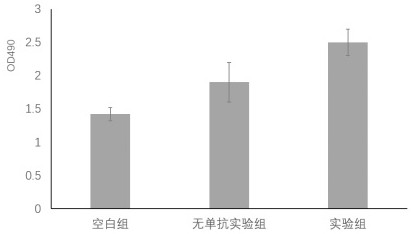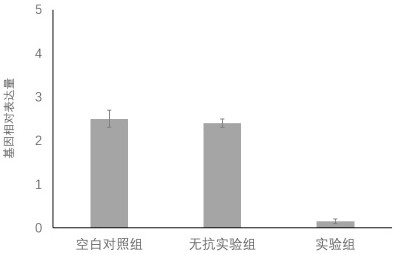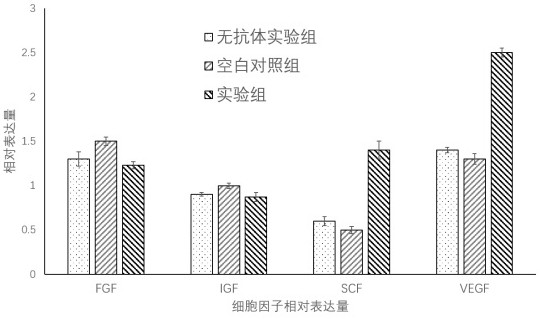Method for effectively improving production of bone marrow mesenchymal stem cell cytokines
A bone marrow mesenchymal and cytokine technology, which is applied in the field of effectively improving the cytokine production of bone marrow mesenchymal stem cells, can solve the problems of not involving the production and enrichment of cytokines, and not verifying the adipogenic differentiation of bone marrow mesenchymal stem cells.
- Summary
- Abstract
- Description
- Claims
- Application Information
AI Technical Summary
Problems solved by technology
Method used
Image
Examples
Embodiment 1
[0019] Example 1 Preparation of monoclonal antibodies specific to PTN
[0020] The optimized PTN highly immunogenic epitope peptide sequence rtgaeckqtmktqrckipcnwkkqfgaeckyqfqawgecdlntalktrtg is synthesized and ready for use. Animal immunization: Four 7-week-old female Balb / c mice were taken, and the antigen was fully emulsified with an equal volume of Freund's adjuvant at a dose of 50 μg / mouse, and injected subcutaneously at multiple points in the abdomen, and boosted every 2 weeks. Seven days after the third immunization, the serum of the immunized mice was collected by picking the eyeball method, which was called the immune serum (positive serum). In addition, serum from unimmunized mice was collected as negative serum. On the 7th day after the 3 times of immunization, blood was collected from the tail vein, and the titer of mouse serum was determined by ELISA detection method. 10μg / mL, coated at 4°C for 12h; 50mg / L skimmed milk powder, blocked at 37°C for 1h; mouse serum...
Embodiment 21A7
[0024] Example 2 Identification of 1A7 monoclonal antibody subtype
[0025]The Mouse Monoelonal Antibody Isotyping Kit from Sigma was used for identification. Take hybridoma cells and mouse ascites and dilute them with PBS at pH 7.2 to make a 1:1O dilution; take 200 μL of the diluted solution and add it to the test tube, let it stand at room temperature for 30 seconds, insert the Isotrip colloidal gold test paper into the bottom of the tube, take it out after 10 minutes, and observe the results . The results showed that the antibody subtype of 1A7 monoclonal antibody was IgG1, and the light chain type was κ.
Embodiment 31A7
[0026] Example 3 Affinity Identification and Sequence Identification of 1A7 Monoclonal Antibody
[0027] The affinity was determined by Surface Plasmon Resonance (SPR). Immobilization of the capture molecule (anti-mouse Fc fragment capture antibody), the channel with the anti-mouse Fc fragment capture antibody immobilized as the detection channel, and the channel with the unfixed anti-mouse Fc fragment capture antibody as the control channel, the process is as follows: (1) surface balance: HBS-EP buffer, equilibrate the chip surface at a flow rate of 10 μl / min for 5 min; (2) surface activation: inject a 1:1 mixture of 'NHS+EDC', activate the chip surface at a flow rate of 10 μl / min for 7 min; (3) couple Coupled antibody: inject goat anti-mouse Fc fragment capture antibody (diluted in 10mM sodium acetate (pH 4.5) buffer), couple at a flow rate of 10μl / min for 7min; control channel omit this step; (4) surface blocking: inject ethanolamine , block the surface for 7 min at a flow...
PUM
 Login to View More
Login to View More Abstract
Description
Claims
Application Information
 Login to View More
Login to View More - R&D Engineer
- R&D Manager
- IP Professional
- Industry Leading Data Capabilities
- Powerful AI technology
- Patent DNA Extraction
Browse by: Latest US Patents, China's latest patents, Technical Efficacy Thesaurus, Application Domain, Technology Topic, Popular Technical Reports.
© 2024 PatSnap. All rights reserved.Legal|Privacy policy|Modern Slavery Act Transparency Statement|Sitemap|About US| Contact US: help@patsnap.com










